As its name implies, the clinical features of Porcine reproductive and respiratory syndrome (PRRS) include two separate pathologies: reproductive failure in sows (mainly characterised by abortions, mummified foetuses and weak-born piglets) and respiratory disease in young pigs.
The disease was noticed for first time in the late 1980s and the causative agent was isolated in 1991. Nowadays, PRRS is prevalent in most countries and exists in epidemic and endemic forms.
More than 25 years after its emergence, PRRS is still considered as one of the most costly diseases to the pig industry worldwide. As a matter of fact, a recent study has estimated losses in the United States at US $668 million annually, exclusive of indirect costs. Additionally, highly-pathogenic strains emerging in China in 2006 affected over two million pigs within a few months, with high mortality rates.
The first vaccine against PRRS virus, based on an inactivated strain, was marketed in 1993. Soon after that, a vaccine based on a modified-live PRRS virus was also available. In the following years, the number of vaccines on the market based on both inactivated and modified-live virus was limited; however, in recent years, their number has increased exponentially.
Thus, at the present time, there are over 30 vaccines, although some of them are only available in their country of origin. Despite all the vaccines available, it is widely accepted that they do not provide either complete or universal protection against PRRS virus infection.
There are two main reasons why such a phenomenon occurs:
- PRRS virus has an extremely high genetic diversity
- PRRS virus strongly modulates the immune response
Nevertheless, vaccines can have beneficial effects in terms of reduction of the transmission and clinical protection. Despite the efforts of the scientific community, with over 4,000 PRRS-related articles published in peer-reviewed journals, our understanding of the disease is still far from complete, and as a result, important questions still remain unanswered.
As a consequence, PRRS virus is now spread all over the world, with a devastating economic impact.
Frequently reintroduced to farms, regions or even countries after the implementation of expensive and cumbersome control/eradication programs, PRRS is considered as one the most challenging diseases in the pig industry.
© Laboratorios Hipra, S.A. 2024. All Rights Reserved.
No part of this website or any of its contents may be reproduced, copied, modified or adapted, without the prior written consent of HIPRA.



